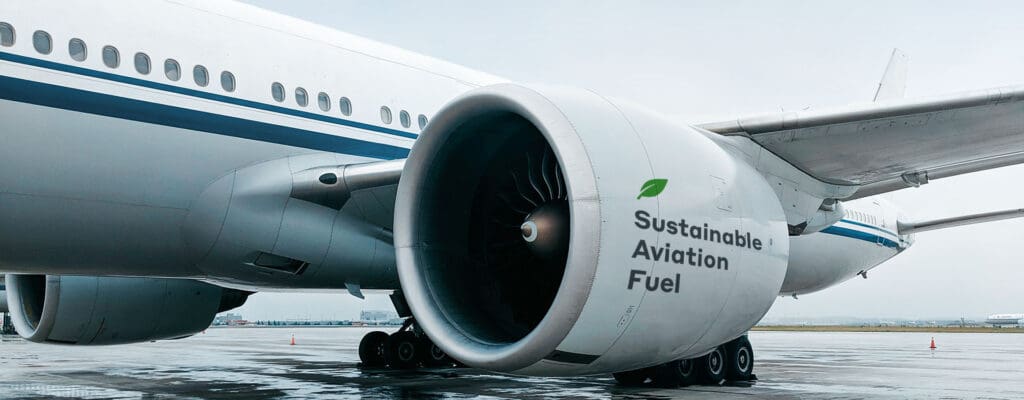All around the world, travelers are choosing more environmentally-friendly ways to get around. According to a recent Business Insider study, about 40% of travelers claim that they would prefer to take fewer but longer trips if that would help reduce their environmental impact.
A further 40% revealed that they would be happy to stay in a “less preferred but greener hotel”, and 1 in 3 are inclined to take public transportation. This holds especially true for younger generations, with 93% of Gen Z-ers and 89% of millennials saying they are willing to change their travel habits for the sake of the environment.
The travel industry itself is also making strides towards creating more sustainable travel. And while there are many new technologies and trends emerging to help achieve this goal, none are quite as promising as sustainable fuel for air travel. Also known as “sustainable aviation fuel” or “SAF”, this represents one of the biggest leaps forward for the aviation industry. Let’s dig into what it is and why it could make such a significant difference.
A little bit of background
We all know that climate change is an issue – specifically anthropogenic climate change. The Theory of Anthropogenic Climate Change posits that humans are causing the most significant changes to our climate by burning fossil fuels like coal, oil, and natural gas. The implications of this have been discussed in great detail. If we reach 1.5 degrees of warming above pre-industrial levels, our world will be shaken by extreme events that will endanger life on Earth.
Travel as a whole is responsible for about 8% of global greenhouse gas emissions, with transport accounting for nearly 50% of that. As it stands, the aviation sector relies on conventional jet fuels that are predominantly petroleum-based. Aviation fuel is, by its very nature, carbon-intensive because it’s based on hydrocarbons. That’s why airlines around the world are making commitments to go carbon neutral and reach their net-zero goals by 2050.
IATA, for example, committed to flying net-zero by 2050 and outlined a number of steps it planned to take to achieve this goal. British Airways, American Airlines, Delta, Jet Blue, Lufthansa, and many other commercial aviation companies have taken to making their own commitments as well.
If the air travel industry wants to reach these targets, it needs to transition away from the use of these traditional jet fuels. But how can they do that? There are really just 3 options for now:
Going electric. This method faces similar problems as hydrogen – we simply aren’t there yet in terms of technology development to be able to support electric planes. That’s not to say it won’t become available in the future, though.
SAF. The great thing about this is that because these engines require minimal development, it’s already being used to power planes today. The research, technology, and development is here now for us to use – meaning that we can reach 100% SAF-powered planes soon. That would lead to a swift emissions reduction of 80% when compared to traditional jet fuels.
So, what exactly is SAF?
Sustainable aviation fuel is a jet fuel that uses biological feedstock to make the oil. Why is that a good thing? If you remember what we learned in biology class back at school, you’ll know that oil comes from millions and millions of years of organic matter progressing through heat and pressure. That’s clearly not an ideal or sustainable long-term solution.
But SAF is different. Sustainable feedstocks are any biological material that can be used directly as fuel and in the case of SAF that can be anything from cooking oil, plant oils, municipal solid waste, waste gases, and agricultural residues. What’s great about that is that you can grow the plants needed for the production of SAF, which in turn take carbon dioxide out of the atmosphere when they grow. This then creates an organic “carbon lifecycle” to generate fuel, which burns, which then is eaten by plants!
How far along the road are we?
Airlines from around the world have committed to the complete use of SAF to fuel 100% of flights by 2050. However in the shorter term, realistically they’ll be able to reach 20% SAF usage by 2030. That’s because it’s actually quite complicated to produce and at the minute the primary issue is that it costs more than fossil jet fuel.
We’re currently in a situation where the supply of SAF needs to be upscaled massively for this to be a viable solution. In 2019, for example, global fuel consumption reached an all-time high at 95 billion gallons. Meanwhile, annual SAF production was at approximately 60 million gallons in 2020, which is likely to climb to 72 million gallons as new SAF producers enter the market. While it’s a great thing that this is on the rise, it’s still not enough to meet global demand and transition us to fully SAF-based travel.
However, that level of demand is going to drive innovation and ultimately make the price go down – we’re seeing a kind of cyclic concept where we need SAF but in order for it to be cost-effective, it needs both investment and demand.
There are two possible ways for SAF to really get off the ground and become the dominant renewable fuel in air transport:
With a top-down approach – where the government mandates a certain amount of SAF usage for airlines within a fixed amount of time to reduce CO2e emissions
With a bottom-up approach – where users and other stakeholders learn about the environmental and commercial benefits of SAF demand that it be used for commercial flights (and later, cargo and transport). This approach is already gaining some traction, with institutes like Imperial College London’s Brahmal Vasudevan Institute for Sustainable Aviation receiving a £25 million philanthropic donation to continue developing clean, safe, and sustainable air travel.
And it’s not unprecedented for the costs of something that’s better for the environment to drop due to interest and demand. Renewable energy used to be extremely expensive and now solar power costs have fallen by 16%, with the wind dropping between 9% to 13%. Even large-scale solar power has fallen by around 85%. It just goes to show that once humans put their minds to innovation, anything is possible!

A window into the future
Of course, there’s no way to know exactly how and when we’ll be able to roll out the use of alternative fuels or biofuels. What we do know is that this is a necessary step towards achieving true sustainability in the travel sector.
I was recently at a summit where I met the CEO of Wright Electric – a company backed by the US government that’s trying to develop electric engines for planes. He seemed to believe that they’d have electric planes in the next few years. That would be an absolute game-changer in reducing the travel sector’s carbon footprint and reaching our net-zero emissions targets.
My two cents on the topic are simply that I believe SAF, and to a certain extent, electric planes are not just the future – they’re the near future. SAF is a low-carbon fuel, reducing carbon emissions by 80% in comparison to the air fuels we currently use. I think this is a first step towards achieving sustainable travel because it doesn’t require any further research and development.
The technology and production facilities are already there for SAF to be used in commercial flights – and as I mentioned above, many airlines are already using it to a certain extent. With a little bit of time and the increasing demand from users, this will become the norm.
That being said, in my opinion, the next step past SAF will be the use of electric planes more so than hydrogen-powered planes. Transportation as a whole is seeing a shift towards electric power, with vehicles going from petrol to electric and trains following a similar path. It stands to reason that air travel will look in that direction as well.
I don’t think that we’re ready for hydrogen in this area just yet. Between the difficulty in producing the resource in the first place and the negative connotations associated with the Hindenburg airship, I think that we have quite a long way to go before this becomes a viable option.
What can travelers and travel managers do to reduce their carbon footprint in the meantime?
There are a number of things you can do to make business or leisure travel more sustainable until SAF becomes more readily available. For instance, you can:
Replace flights with rail travel for short-haul journeys. In fact, this is being enshrined into law in countries like France, which are making it mandatory to take the train on trips with a duration of 2.5 hours or less.
Take a direct flight to your destination when you can. On average, direct flights can reduce carbon emissions by about 100 kg/person in comparison to flights that include a layover! Try booking a flight with the most fuel-efficient long-haul aircraft. For example, flights operated on a Boeing 787-9 are 60% more efficient than flights operated on an A380, at just 39 passenger kilometers per liter of fuel.
Think about carbon budgeting by integrating your company’s maximums straight into your travel policy. Learn more about global carbon budgeting and how to meet these goals through travel here!
What about carbon offsetting?
Yes, travelers and travel managers (or really, anyone booking or organizing travel of any kind) can consider carbon offsetting as a step in the right direction. It isn’t the perfect solution, but it’s the best we’ve got until SAF and other sustainable travel technologies become more readily available.
It’s true that not all environmentalists are completely convinced by carbon offsetting for a number of reasons – from inaccuracies to manipulation to additionally. However, in theory, carbon offsetting works because it allows anyone to be part of the global quest to tackle greenhouse gas emissions. The idea is that any company or individual can contribute to offsetting schemes and help reduce carbon emissions regardless of their location or circumstances.
This is something that’s been endorsed by IATA with its Carbon Offsetting and Reduction Scheme for International Aviation (CORSIA) scheme, and is something that we at TravelPerk also offer our customers.
With GreenPerk, TravelPerk customers can offset 100% of their business travel-related carbon footprint. At just ~0.9% of the total cost of any trip, we invest in VERRA-certified carbon offsetting projects on behalf of our customers that focus on forestry, biogas capture, and renewable energy to name a few. We’ve also developed GreenPerk API, an open API for companies to understand where and how they are emitting carbon when traveling for business. They can then use this data to help them reach their net-zero goals.
The post What is sustainable air fuel and why should you care? appeared first on TravelPerk. For more on travel.


